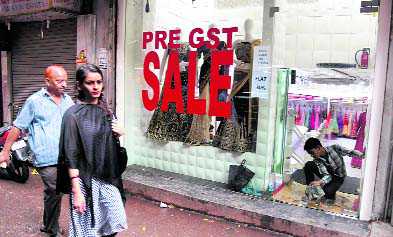Before the implementation of GST, showrooms in Delhi started special sale and offered discount on clothes on Friday. Tribune photo: Manas Ranjan
Advertisement
- February 1986: FM VP Singh proposes a major overhaul of the excise taxation structure in the Budget
- 2000: PM Vajpyee introduces the concept, sets up a committee headed by the then West Bengal FM Asim Dasgupta to design a GST model
- 2003: The Vajpayee government forms a task force under Vijay Kelkar to recommend tax reforms
- 2004: Vijay Kelkar, then adviser to the FinMin, recommends GST to replace the existing tax regime
- February 28, 2006: GST appears in the Budget speech for the first time; FM P Chidambaram sets an ambitious April 1, 2010 as deadline for GST implementation
- 2008: Empowered Committee of State Finance Ministers constituted
- April 30, 2008: The Empowered Committee submits a report titled ‘A Model and Roadmap Goods and Services Tax (GST) in India’ to the government
- November 10, 2009: Empowered Committee submits a discussion paper in the public domain on GST welcoming debate
- 2009: FM Pranab Mukherjee announces basic structure of GST as designed by Dasgupta committee; retains 2010 deadline
- BJP opposes GST basic structure
- February 2010: Finance Ministry starts mission-mode computerisation of commercial taxes in states, to lay the foundation for GST rollout
- Pranab Mukherjee defers GST to April 1, 2011
- March 22, 2011: UPA-II tables 115th Constitution Amendment Bill in the Lok Sabha for bringing GST
- March 29, 2011: GST Bill referred to Parliamentary Standing Committee on Finance led by Yashwant Sinha
- November 2012: Finance Minister P Chidambaram holds meetings with state finance ministers; decides to resolve all issues by December 31, 2012 for GST rollout
- February 2013: Chidambaram in his Budget speech makes provision for Rs 9,000 crore to compensate states for losses incurred because of GST
- August 2013: Parliamentary standing committee submits report to Parliament suggesting improvements on GST. GST Bill gets ready for introduction in Parliament
- October 2013: Gujarat CM Narendra Modi opposes GST Bill saying state would incur losses worth Rs 14,000 crore every year due to GST
- 2014: GST Bill cleared by Standing Committee lapses as Lok Sabha dissolves; BJP-led NDA government comes to power
- December 18, 2014: Cabinet approves 122nd Constitution Amendment Bill to GST
- December 19, 2014: FM Arun Jaitley introduces the Constitution (122nd) Amendment Bill in the Lok Sabha; Congress objects
- February 2015: Jaitley sets April 1, 2016 as deadline for GST rollout
- May 6, 2015: Lok Sabha passes GST Constitutional Amendment Bill
- May 12, 2015: The Amendment Bill presented in the Rajya Sabha
- Congress demands the Bill be sent to Select Committee of Rajya Sabha; demands capping GST rate at 18%
- May 14, 2015: The GST Bill forwarded to joint committee of Rajya Sabha and Lok Sabha
- August 2015: Government fails to win the support of Opposition to pass the bill in the Rajya Sabha where it lacks sufficient number
- July 2016: Centre opposes capping GST rate at 18%; gets states around
- August 2016: Congress, BJP agree to pass the Constitution Amendment Bill
- August 3, 2016: Rajya Sabha passes the Constitution Amendment Bill by two-thirds majority
- September 2, 2016: 16 states ratify GST Bill; President Pranab Mukherjee gives assent to the Bill
- September 12: Union Cabinet clears formation of GST Council
- November 3: GST Council agrees on four slab tax structure of 5, 12, 18 and 28% along with an additional cess on luxury and sin goods
- January 16, 2017: Jaitley announces July 1 as GST rollout deadline.
- February 18: GST Council finalises draft compensation bill providing to make good any revenue loss to states in first five years of GST rollout
- March 4: GST Council approves CGST and Integrated-GST bills
- March 20: Cabinet approved CGST, IGST and UT GST and Compensation bills
- March 27: Jaitley tables CGST, IGST, UT GST and Compensation bills in Parliament. Lok Sabha and Rajya Sabha pass all the four key GST Bills
- May 18: GST Council fits over 1,200 goods in one of the four tax slabs of 5, 12, 18 and 28%. Over 80% of goods of mass consumption either exempted or taxed under 5% slab
- GST Council fixes cess on luxury and sin goods to create kitty for compensating states
- May 19: GST Council decides on 5, 12, 18 and 28% as service tax slabs
- June 21: All states except Jammu and Kashmir pass SGST law
- June 28: Mamata Banerjee announces her party’s decision to skip midnight launch of GST
- June 29: Congress, Left too decide to skip launch PTI
Advertisement
×
Unlock Exclusive Insights with The Tribune Premium
Take your experience further with Premium access.
Thought-provoking Opinions, Expert Analysis, In-depth Insights and other Member Only Benefits
Combo
Yearly
Monthly
Already a Member? Sign In Now
Advertisement
Advertisement
Advertisement










